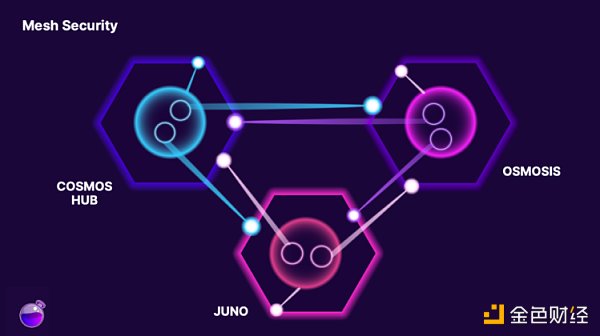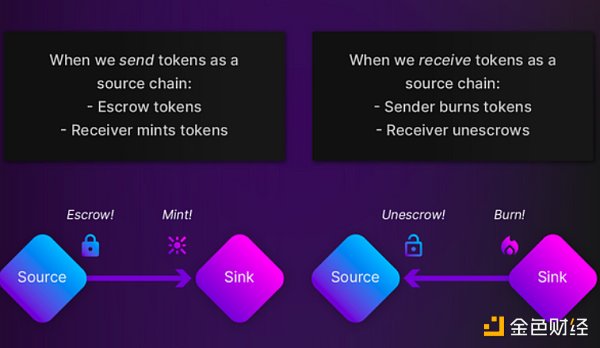Overview of Outlier Ventures’ 6 Cosmos investment portfolio projects
Overview of Outlier Ventures' 6 Cosmos portfolio projectsAuthor: Victor-Cristian Florea, Outlier Ventures; Translator: LianGuai0xjs
Cosmos Ecosystem Update
“Cosmos Hub Whitepaper v1.2”
To address the 51% attack faced by new chains, Cosmos introduces a cross-chain security mechanism in their new whitepaper, which is scheduled to be launched in the second quarter of 2023. This mechanism allows chains to lease security from Cosmos Hub, similar to Polkadot’s shared security model. However, Cosmos’ cross-chain security offers greater flexibility, allowing application chains to pay a percentage of transaction fees to validators in exchange for security. To reduce dependence on Cosmos Hub, the co-founder of Osmosis proposed the Mesh Security solution. With this technology, each chain can have its own set of validators, and Cosmos Hub validators can participate in the consensus of consuming chains. This mesh structure ensures economic communication and promotes closer collaboration, enhancing the power of validators and promoting equality among chains.
Another important proposal in the new whitepaper involves introducing liquid staking to cross-chain. The new liquid staking model of Cosmos Hub generates revenue from various sources, including interchain transaction fees and interchain security fees. The redesign of the ATOM token issuance scheme aims to increase its weight and value capture capabilities, aligning it with the new functionalities of Cosmos Hub. The whitepaper envisions that this “cross-chain liquidity market will become a catalyst for ATOM throughout the cross-chain deployment, building new waves of innovation for security-based Cosmos native collateral.”
To provide a universal system for decentralized autonomous organizations (DAOs), Cosmos Hub also introduces a governance stack. This framework includes a consensus council, a cross-chain security council, and an allocation DAO, providing standardized governance models for all DAOs. The power hierarchy model defines the relationships and responsibilities between different organizations, enabling Cosmos Hub to make important decisions on crucial matters such as the balance of treasury funds and interests between Dapp chains.
- Summary of the latest Ethereum core developer execution meeting Devnet-9 launch delayed again, Holesky test network validator participation rate close to 80%.
- Vitalik Should Ethereum integrate more functions at the protocol layer?
- The enthusiasm for the ‘Anti-Shib Movement’ is high, ‘Abandoned Child’ CAL becomes the most powerful weapon.
The proposed upgrade of Cosmos Hub aims to address the fragmented state of the Cosmos ecosystem and enhance the value capture capabilities of the ATOM token. By building new modules and implementing advanced features, Cosmos Hub seeks to become the core of the network. With the recently announced implementation of native USDC, it is expected that the ATOM/USDC trading pair will generate significant fee income and unlock new use cases for the ATOM token. However, the proposed upgrade for restructuring Cosmos Hub failed to pass the community’s voting session and has never reached the production stage.

Figure 1 – Osmosis Blog
IBC
The Inter-Blockchain Communication (IBC) protocol addresses a specific problem – cross-chain communication. It achieves this by providing a way to transfer data packets between blockchains without permission. While IBC initially focused on token transfers (Figure 2) and cross-chain state interactions, its potential use cases have expanded to include more complex applications such as transfer security and trust (Figure 1). The efforts of Informal Systems and Interchain GmbH’s Aditya SriLianGuail in designing and implementing cross-chain security are commendable.
In addition to the core development team, some projects are actively exploring innovative IBC applications and striving to integrate IBC with other ecosystems. Exciting initiatives include IBC bridges connecting to Polkadot, Ethereum, Avalanche, and cross-rollup communication. Furthermore, projects like Babylon and Penumbra are leveraging IBC to enhance security and unlock new functionalities for IBC-enabled chains. Secret Network, on the other hand, utilizes IBC to provide fast and secure VRF access for the entire ecosystem, offering on-chain randomness.

Figure 2 – “IBC Token Transfer” – Cosmos Developer Portal
Outlier Ventures’ 6 Cosmos Portfolio Projects
Therefore, our portfolio consists of 6 projects focused on building within the Cosmos ecosystem. Here are the latest updates on Outlier Cosmos investment projects:
Agoric
In 2022, Agoric, the blockchain enabling JavaScript smart contracts within the Cosmos ecosystem, reached the conclusion of Mainnet-1 after four years of development, marking a significant milestone for the platform. The launch of Mainnet-1 took place on October 27, 2022, followed by the Mainnet-1B upgrade, introducing enhanced features such as Agoric VM, an Oracle network, and a set of Hardened JavaScript smart contracts.
The first decentralized application on the Agoric blockchain is Inter Protocol, which serves as the hub for stablecoins enabled by IBC within the Cosmos ecosystem, specifically IST. In the first half of 2023, users could only mint IST using stablecoins like USDC, USDT, and DAI. However, starting from this summer, they can also use volatile assets as collateral in the minting process. The Inter Protocol team has just launched the ATOM Insurance Vault on the Mainnet version of the application, allowing users to deposit ATOM tokens and mint IST against their collateral.
Cudos
Cudos is a Layer 1 blockchain and Layer 2 community-governed cloud computing network that provides Infrastructure as a Service (IaaS) market to deliver decentralized, permissionless, high-performance cloud computing at scale. Cudos’ blockchain compute technology combines cloud and blockchain into Web3, with its native utility token CUDOS playing a crucial role in driving the platform. Cudos aims to fully merge cloud and blockchain services, advocating user privacy and sustainability, and providing decentralized computational resources for the masses.
One of the latest decentralized applications on the Cudos Blockchain is Cudos Markets, a sustainable asset NFT marketplace that allows users to buy, sell, and collect Bitcoin mining power NFTs. Ownership of the NFT grants users access to mining power for a duration of 4 years, during which the holders will receive mining rewards related to the mining power they own on Cudos Markets. The long-term goal is to provide a fully decentralized marketplace for all computational needs.
Secret Network
In May 2023, Secret Network launched Secret VRF, a secure and verifiable random number generator (RNG) that is now available for developers to use. This RNG enables the creation of truly random numbers on the blockchain without compromising security or availability. It eliminates the need for off-chain solutions that are often unreliable, centralized, expensive, and detrimental to user experience. Secret VRF addresses the technical challenges of on-chain RNG by generating unpredictable yet deterministic random numbers within a trusted execution environment (TEE). Secret VRF is designed to provide verifiable on-chain randomness, unlocking many new Web3 use cases for the Cosmos universe. This significant breakthrough reduces reliance on Chainlink VRF Oracles within the Cosmos universe. This useful tool can be utilized by the Secret Network community as well as other Cosmos chains enabled with IBC as the foundation for secure randomness across the Interchain.
Fetch.AI
The latest version of Fetch’s Agentverse, Agentverse v5, has been launched, which includes a new feature that allows agents to have wallets. With this update, agents can interact with the Fetch.ai ledger, send and receive transactions, and leverage unlimited possibilities. Developers can now interact with the Fetch.ai ledger seamlessly using the ctx.ledger and ctx.wallet objects, enabling transactions. This new feature enables agents to send tokens directly from their wallets to specific addresses, facilitating payments or enabling token transfers. The Agentverse editor displays the wallet address of the agent at the top of the page, making it more convenient to manage the agent’s wallet. It also facilitates agent-to-agent transactions, thanks to the integration of the Agentverse wallet.
Agentverse provides a user-friendly platform for creating, testing, and deploying agents, regardless of the user’s level of experience with agent-based technology. Utilizing the new features of v5 will help build intelligent agents that can seamlessly interact with the Fetch.ai ledger.
Cheqd
In Web3, zero-knowledge proofs (ZKPs) are a hot topic, with a multi-protocol initiative that sees the emergence of new tools to provide consumers with more private and independent online experiences. As a result of collaborations between the famous SSI frameworks, Hyperledger Indy and Hyperledger Aries, and Cheqd’s main partner, Animo, Cheqd recently announced support for zero-knowledge credentials (ZKCreds). They now offer their partners the well-known “AnonCreds” verifiable credentials.
Recently, Cheqd launched creds.xyz, a new protocol for ZKCreds. Creds is a core component of the project, providing a way to establish reputation and prove authenticity in a private and secure environment. In contrast to NFTs and SBTs, Creds are both transferable, adaptable to various platforms and ecosystems, and private, allowing users to control who can access their information while being revocable, providing users with configurable access control. Creds can also help users prove that they are human, not AI.
Kima Finance
Kima aims to eliminate the fragmentation of DeFi by providing open infrastructure and building blocks for cross-chain applications. Due to technical, financial, and regulatory barriers, DeFi is currently fragmented, with liquidity pools, options, insurance vaults, strategies, and futures contracts locked within the boundaries of networks and smart contracts. This fragmentation leads to poor user experience, limited functionality, insufficient liquidity, and high costs. In order to increase adoption and unlock value, DeFi must become non-fragmented, with interoperability, interconnectedness, user-friendliness, and intelligent services.
The Kima protocol provides powerful technical infrastructure, pre-built functional blocks, token economics, and applications to address these issues and create a more seamless DeFi experience. They have just announced the public demo deployment of their application on Devnet, allowing users to test various features of their product suite.
Conclusion
Cosmos is a growing ecosystem with new innovative chains constantly being developed. With clever improvements centered around IBC and cross-chain support, as well as continuous development regarding existing application chains, security, interoperability, and user experience, they are better than ever before.
We will continue to update Blocking; if you have any questions or suggestions, please contact us!
Was this article helpful?
93 out of 132 found this helpful
Related articles
- Overview of the selected projects for the second phase of Outlier Ventures’ Zero Knowledge Base Camp
- ETHGlobal New York Hackathon 13 Winning Projects Overview
- ETHGlobal New York Hackathon A Review of the 13 Finalist Projects
- Quick Look at the 13 New Projects Shortlisted for the ETHGlobal New York Hackathon Finals
- Inventory of 10 blockchain projects that recently received investments from well-known VCs Freatic, LianGuairallax, Socket…
- Sorry, we failed. Multiple projects have been shut down one after another. Is the shutdown wave coming to the cryptocurrency industry?
- Multiple projects announce shutdowns in succession, is the encryption industry ushering in a ‘shutdown wave’?






